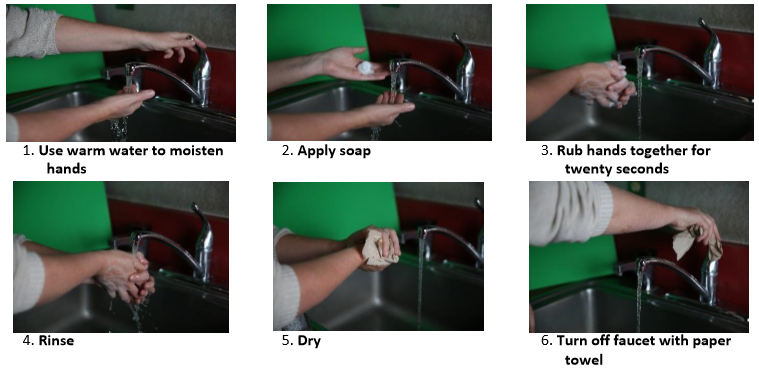What is a foodborne illness?
A foodborne illness is commonly referred to as food poisoning or “stomach flu”. Many different types of bacteria, viruses, parasites, and mold occur in food and can cause illness, usually in the form of gastroenteritis. While the general population is at risk, there are certain groups that are highly susceptible and may experience severe cases and even death. Those groups are the very young, the very old, the immunocompromised, and women that are pregnant.
The FDA has identified 5 most common, highly infectious pathogens (“The Big 5”) that have a low infectious dose and can be easily transmitted to food even when good handwashing practices are used. Illness experienced by the consumer can be very severe. The Big 5 are: Norovirus, Salmonella Typhi, E. coli 0157:H7, Shigella, and Hepatitis A. The most common is Norovirus. Hepatitis and Norovirus are viruses. Salmonella, E. coli and Shigela are bacteria. All of these are spread by an oral-fecal route.
Norovirus
Norovirus is highly contagious and causes sudden onset of severe vomiting and diarrhea. The virus is commonly spread through food or water that is contaminated by fecal matter during preparation. Often called the “cruise ship virus”, it occurs most frequently in closed or crowded environments. You can be infected by close contact with others that are infected or even by touching surfaces that are contaminated (fomites) such as door knobs or menus. Also, when a person vomits, small particles are in the air and another person may ingest the particles and become infected.
Signs and symptoms usually begin 24 to 48 hours after first exposure to the virus and last for several days. Infected persons may shed virus in their feces for up to three days after recovery.
Hepatitis A
Hepatitis A is a contagious liver disease caused by the Hepatitis A virus. The virus is spread by consuming food or water contaminated by fecal matter or from close contact with someone who is infected.
Signs and symptoms typically don’t appear until you’ve had the virus a few weeks and may include: fatigue, nausea and vomiting, and yellowing of the skin and eyes (jaundice). Food facility employees with jaundice must not return to work and must be cleared by a physician and the local health department before returning to work.
What can I do about it?
- Practice good hygiene.
- Thoroughly wash hands after using the toilet, changing a diaper, before preparing food, and before eating. Scrub vigorously for at least 20 seconds with soap and rinse well. Dry hands with a disposable towel and avoid activity that could potentially re-contaminate your hands before resuming work.
- Stay at home. Don’t go to work. Don’t prepare food for others while actively infected, even your family. Viruses are easily passed to others.
- Use a bleach solution to wipe door knobs and food contact surfaces like tables and counters.
- At work, clean menus, tables, chairs, and food contact surfaces with an adequate sanitizer solution.
What food facility managers should be concerned about…
- Vomiting or Diarrhea – ask the employee to stop work and leave the food facility immediately and return to work no sooner than 24 hours after vomiting and diarrhea have ended (longer if Norovirus is diagnosed)
- Jaundice (yellowing of the skin or eyes) – have the employee stop work immediately and exclude from the facility – cases of jaundice must be reported to the local health department and employees may not return to work until cleared by a physician AND the local health department
- Sore throat with fever- employees may be placed on restricted duty (no food service) but must be excluded if working with a highly susceptible population
- Open sores or cuts on hands and wrists- restrict the employee from working with food until area is properly covered and healed
The key is PROPER HAND WASHING
Food can be contaminated at any point along the process: growing, harvesting, processing, handling, and even after cooking. However, if a food handler is infectious and has poor hygiene, the risk goes up for patrons of the restaurant. Proper handwashing is one of the most important tools to prevent the spread of disease. Always wash hands after using the toilet, before starting work, after eating or smoking, after every possibility of contamination, and between tasks.
Gloves are NOT a substitute for handwashing! Wash hands before putting on gloves and when changing into a fresh pair. Change gloves as soon as they become soiled or torn and before beginning a new task.
Use the right technique...

